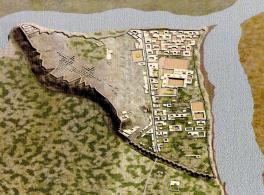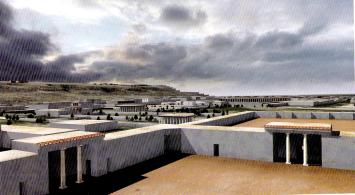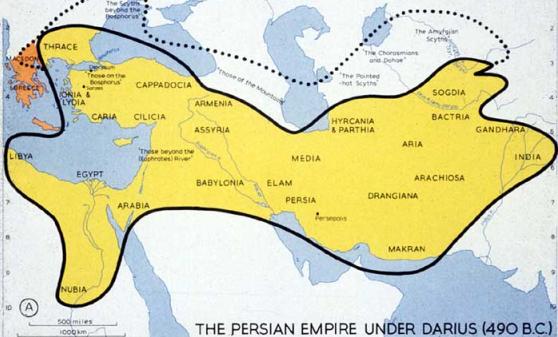The strength of
metropolitan development in Central Asia has a long history with urban
development that can be traced back to the Bronze Age and continuing under the Achaemenids
and the Greeks, following Alexander's brief incursion. The full flourishing of
these ancient cities, however, next seems to have taken place as a consequence
of the lengthy peace brought about by Kushan imperial rule. This millennium was
one of considerable prosperity in Central Asia, reflected by the remains of
numerous large cities, such as Merv, Toprak kala, Ayaz kala, Afrasiab, Varakhsha,
Panjikent, Termez, etc.
Following is a computer-aided reconstruction of the Hellenistic city of Ai
Khanum:


For
most classicists of the Mediterranean world, Central Asia is known essentially
for its Hellenistic past, beginning with the expedition of Alexander in 329-327
BC.] However, north of the Hindu Kush, this period, which ended between about
145 and 130 BC, was only a brief event in the history of the region. Since the
beginning of the Iron Age, Central Asian oases have known endless invasions and
migrations, and a permanent interaction between sedentary, semi-mobile and
nomadic populations is evident.
The
position of the frontier between Bactria and Sogdiana appears to have changed
between the Iron Age and the Kushan period, with a progressive reduction
northward of the territory of Sogdiana from the region of the Darya-i Pandj to the Baysun and Hissar ranges. The
geography of the Oxus and the Ochus as presented in the
sources for Alexander's expedition indicates that in the late Achaemenid and
Hellenistic periods the northern Bactrian frontier probably lay along the Amu-darya and the Wakhsh, rather than
at the Iron Gates or along the Amu-darya and the
Darya-i Pandj. This
research has no implications for the archaeology, since before the Kushans the
cultural context was very similar on both sides of the Oxus; it is doubtful
that the now traditional term 'Northern-Bactrian' for the right bank of the
Oxus-the classical Oxiana region-will ever be
changed, but subtleties should not be forgotten when historical interpretations
focus on defined 'ethnic' locations along the frontiers or peripheral regions.
As
can be inferred from the discoveries of Ai Khanum, Bactria was, in the
Hellenistic period, a major cultural centre, from
which Greek culture radiated throughout Central Asia. But, from an economic
point of view, nothing appears to prove that the GraecoBactrians
were interested economically by their position on the main crossroads of Asia.
The scarcity of coins on the site of Afrasiab and in its region is probably due
to the short time of Hellenistic power, but it also suggests that in the
Hellenistic period, trade in northern Sogdiana was not based on a developed
monetary system (GraecoBactrian coins were mainly
diffused in the form of imitations only by later nomad authorities). In
Bactria, on the other hand, the monetary finds do not present such concentration
as in the Indian area. So far as international commerce is concerned, the
imports to Ai Khanum are limited to a few 'occidental' products, like
Mediterranean plaster mouldings on metallic vases for
the Graeco-Bactrian artists, olive oil for the gymnasium activities, or books
for the library, whereas the Indian objects collected mainly in the treasury of
the palace have simply been identified as booty from Eucratides'
Indian expeditions against Menander. (After Alexandrer:
Central Asia before Islam, 2007, p.63.)
Another
constant of Central Asian life has been 'Invasion', either of expanding
imperial powers, such as Alexander and his successors or the Sasanian empire,
or by nomads, such as the Saka or Yuezhi.
Despite
their direct links represented, for example, by the eastern imports identified
at Nisa (Bactrian royal gifts or war booty?), the
Parthians were probably partially responsible for the economic isolation of the
Graeco-Bactrians from the western world. Before their disappearance, the
Graeco-Bactrian economy appears therefore to have been based more on local
natural resources and regional crafts than on any international commercial
potential, whereas the links perceived with the Indo-Greek world tended to be
of an ideological, political and military nature. Therefore, it is important to
underline the role of the nomads in the renewal of cultures and in the
development of international trade in Central Asia. The network of commercial
routes between China, India and the western world through the steppe and later
through the Indian Ocean corresponds to the so-called 'Silk Road'. Its real
beginning is difficult to date, and this event is not necessarily a direct
consequence of the disappearance of the Graeco- Bactrian rulers. The first
links with China in the last third of the second century Be are related to the
initiative of its emperor, who sent his ambassador Zhang Qian. The main
information provided by the report of this envoy is that all the roads between
China and Central Asia were controlled by mobile nomads. The identity of the
merchants active in Lan-shi (see above) is difficult
to determine. Their presence does coincide with the period of the plundering of
the Graeco-Bactrian kingdom, and does not imply the involvement of a wide
commercial system. Trade on a large scale probably begins later, when the
Scythian and Kushan power in northern India appears well established and
connected to the northern regions through roads affording sufficient security
to travellers. The opening of international trade is
therefore to be dated around the beginning of the first century AD, 57 in the
period represented by the rich nomad burials of Tillya
Tepe and Koktepe.
The
ethnic and cultural identities and migration routes of Central Asian nomadic
tribes present one of the most disputed questions of those related to the
Kushans. The tribes appear in literary sources preserved mainly in Chinese
chronicles and in scarce references in the works of Greek and Latin authors.
The migration of Central Asian nomads, particularly into Transoxiana can be
divided into two categories. The long 'trans-regional' route is ascribable to
the Yuezhi migration from the valley of Gansu, on the northern borders of
China, to the territory north of the Oxus River (Amu Darya), while the
migration of tribes like the Dahae, Sakaraules, Appasiakes, Parnes etc. can be classified as 'local' movements.
After
being defeated by the Xiongnu, the Yuezhi migrated
westwards. The first to clash with them were the Wusun. According to the
Chinese chronicles, the Wusun initially inhabited territory in eastern Turkestan
prior to being defeated by Xiongnu in 176 BC. In
about 160 BC, the Wusun moved to the area of Semirech'e
following the same path as the Yuezhi. According to this version of events the
locally found Wusun cultural remains must be dated no earlier than the second
century BC. However, some investigators also attribute monuments of both
earlier and later periods to the Wusun culture. They identify as Wusun most of
the necropolis remains of the third century BC to fifth century AD in Semirech'e, Tian Shan, the valley of Ta1as, and at the foot
of Karatau. This interpretation is not sufficiently
substantiated as it is based on the absence of reliable chronology and a
contradictory interpretation of literary sources. According to Kazim Abdullaev a leading Researcher at the Institute of
Archeology of Uzbekistan, literary sources recount how the Yuezhi on their long
journey from the valley of Gansu met different peoples. The first were the
Wusun. After their defeat by the Wusun in the region of Semirech'e,
the Yuezhi migrated further in a westerly direction. Passing through Da Yuan,
they reached the region between the two rivers of Amu Darya and Syr Darya. Here, north of the Oxus River, they found
another tribe already settled for some time, whom we can hypothetically
identify as the Sakaraules.
This
tribe is linked with the culture of the archaeological monuments of lower Syr Darya and is placed in eastern provinces of Khwarezm (Choresmia) and have
been identified with the Kangju. In approximately the
third to first half of the second century BC, these tribes migrated in a
southern direction and settled around the Samarkand and Bukhara oases. In all
probability, one can connect the representatives of the culture of the Orlat kurgans (tumuli) with the tribe of the Sakaraules, who dwelt in former times in the region of Kangju. If we follow this scheme further, the territory of
the Sakaraules accords with the description in
Strabo, who locates them as coming originally from the region beyond the
Jaxartes river.
The
discovery of a 'Sasanian' relief published in After Alexandrer:
Central Asia before Islam, 2007, found on a cliff in central Afghanistan,
rather than Iran, shows a rhinoceros hunt, which appears to symbolize a
Sasanian king's conquest of 'India'.
Buddhism
spread to Bactria in the Kushan period thanks to its support from the Kushan
nobility. In the first to third centuries there is a considerable flowering of
Buddhist art to be observed, mainly that of the monumental variety (sculpture,
wall-paintings), which was also made possible by support from the Kushan
nobility. Most of the work on the decoration of Buddhist monuments at that time
was undertaken by professional artists, who did not belong to the Buddhist
community. In their work they made use of the iconography of the two main centres of Buddhist art-Gandhara
and, to a lesser extent, Mathura. Analysis of the works of art in Bactria of
the Kushan period has shown that the influence of Buddhist iconography on
non-Buddhist art was minimal.
In
the early medieval period certain changes took place in the social composition
of the community of Buddhist believers in Bactria-Tokharistan.
Buddhism ceased to be merely a religion of the nobility and began to spread
among the ranks of the common people and probably not just in the towns. The
Buddhist buildings of Tokharistan were being
decorated by Buddhist artists by this time, and they were working within the
framework of the artistic tradition of the region. Examples have been recorded
of the influence of Buddhist iconography on non-Buddhist sculpture in the Early
Medieval period. In addition the main influence on the development of Buddhist
art in Tokharistan at that time was from Kashmir,
which became an important centre of Buddhist teaching
and art in the second half of the first millennium. The spread of Islam in Tokharistan put an end to the development of Buddhist art
in the region. Yet, the influence of Buddhist iconography is thought still to
be discernible in the Islamic art of Transoxania in
the tenth and eleventh centuries.


For updates click homepage
here